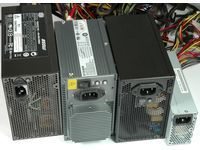Efficiency: Core 2 Nukes Atom On The Desktop
The Power Supply Matters!

System efficiency does not only depend on the core components you use, but it is highly dependent on the power supply, since all power supplies have a certain efficiency when they convert 110 or 220/230 V AC power into 3.3 V, 5 V, and 12 V DC power. Depending on how complex the power supply is, and on how it is laid out (one rail, multiple rails), it will demonstrate certain efficiency characteristics.
As all PSUs have a power loss, efficiency is typically rated in percentage terms. The industry standard for measuring and rating efficiency is called 80 Plus, and it splits power supply units into three categories: bronze, silver, and gold. An 80 Plus rating approaches 90% power efficiency at varying loads, taking low, medium, and high loads into account and specifying this as a percentage of the total output.
Here’s the issue: if a 1,000 W power supply unit is rated excellent at low load, this means that “low load” is still a rather high power in the case of our two systems, which idle at less than 30 W. At such a low load, the excellent 80 Plus, 1,000 W power supply unit will show rather pathetic power efficiency just because it wasn’t designed for such a load.
We decided to run the Foxconn G31 system and the Core 2 Duo E7200 with four different power supplies that are rated at 1,000 W, 850 W, 300 W, and 220 W. You will find the results on the following page, and they should convince you to get a power supply that matches your system’s requirements, as the power requirement differences are larger than the difference in power consumption that you would get by exchanging the E7200 for a Core 2 Duo E8600.
1000 W: OCZ EliteXstream 1000


We used a high-end OCZ power supply to test power consumption for such a hardcore power supply unit. The EliteXstream 1000 is an excellent device. Designed by PC Power and Cooling, it is rated 80 Plus and offers an 82% level of efficiency. An active power factor corrector (PFC) and lots of connectors are mandatory for such a high-end product, which is targeted at workstations and high-end gaming. The device comes with an impressive five-year warranty. However, the device is overkill for our low-power systems, as you will see on the next page.
850 W: Coolermaster Real Power Pro RS850 EMBA
Stay on the Cutting Edge
Join the experts who read Tom's Hardware for the inside track on enthusiast PC tech news — and have for over 25 years. We'll send breaking news and in-depth reviews of CPUs, GPUs, AI, maker hardware and more straight to your inbox.


Cooler Master’s 850-W RS850-EMBA has been our reference power supply for almost a year. We use it for many of our reviews, as we appreciate its powerful and reliable qualities. It is also backed by a five-year warranty, is 80 Plus compliant, and definitely well-equipped for an enthusiast user’s requirements.
300 W: Etasis EFN-300


We didn’t have a power supply at 400-500 W available at the time we finished this article, but we found a 300 W model by Etasis, the EFN-300. Etasis Electronics is not one of the big, popular brands, and the EFN-300 isn’t special in any way except that it is a no-noise device rated at 300 W output. While it likely will not impress enthusiasts, the power supply unit helped to decrease the system’s power consumption compared to the Cooler Master and OCZ power units.
220 W: Fortron FSP220

If you remember our recent articles on VIA’s Nano vs. the Intel Atom and the comparison of Foxconn and Gigabyte G31 motherboards, then you might also remember the FSP220 from Fortron, which is a compact 220 W power supply.
This one is rated for an even lower maximum output and some of you might wonder why we even bothered to use it. Clearly, this is the power supply that allowed us to reach the lowest overall power consumption numbers, as it is capable of answering the power demands of the Atom and Core 2 systems at a much higher efficiency level than the other power supply units we tried.
Current page: The Power Supply Matters!
Prev Page Core 2 Duo E7200 and Foxconn G31MG-S Next Page Power Consumption With Different PSUsMost Popular

